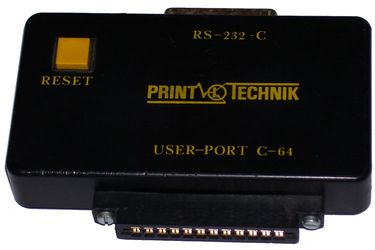RS-232
From C64-Wiki
Jump to navigationJump to search

|
This article is very short and not very detailed. Please help to improve it. |

RS-232 is a communications standard developed for computers. The Commodore 64 does not have the standard implementation and needs to be adapted to communicate with standard RS-232 computers or peripherals. The decision for this was based on keeping the price of the C64 as low as possible.
RS-232 communications are handled through the User Port. Access through this port is done by POKE commands. Refer to User Port for more specific information.
C64 - RS232 interface[edit | edit source]
From HwB
User Port C64 C64 RS232
_________
| |
PA2 M-----------11-| |-14------------------- TXD (2)
PB1 D-----------10-| |--7------------------- RTS (4)
PB6 K-----------12-| MAX 232 |-13------------------- CTS (5)
FLAG2 B---X--------9-| |--8------------------- RXD (3)
PB0 C---| | |--3--|+-|
VCC 2-----------16-| |--1-----| DB25 plug
GND N------X----15-| |
X--|+-2-| |--5--|+-|
X--+|-6-|_________|--4-----|
|
|---------------------------------------- GND (7)
-|+- capacitor 22µF/16V
- +
Programming in BASIC[edit | edit source]
The programming of this interface can be done in BASIC with the normal input/output commands (OPEN, CLOSE, PRINT#, CMD, GET#, INPUT#) and the system variable ST, but with the following caveats:
- The OPEN command allocates two data buffers of 256 bytes (one for output and one for input) and will in the process run the CLR command, which clears all variables! If the program has less than 512 bytes variable memory free, the last part of the BASIC program is overwritten!
- CLOSE removes both buffers and clears the variable memory again. If data is in the output buffer then it will also removed. Check that the output buffer is empty before closing.
- Using INPUT# isn't recommended, because it hangs the program and must be stopped with RUN/STOP +RESTORE .
Example Listing[edit | edit source]
10 REM *************** control register settings 15: 20 BR=6: REM 300 baud 30 DB=0: REM 8 data bits (one a parity bit, see line 80) 40 SB=0: REM 1 stop bit 45: 50 REM *************** command register settings 55: 60 HS=1 : REM X-wire 70 UA=0 : REM full duplex 80 PA=160 : REM mark parity (8.databit always 1) 90: 100 REM ************** general settings 105: 100 LF=20: REM logical file number (any will do) 110 GA=2a: REM device number of RS-232 interface 120 SA=0e: REM secondary address 125: 200 OPEN LF,GA,SA, CHR$(BR+DB+SB) + CHR$(HS+UA+PA)
After that you can use the following commands:
Links[edit | edit source]
| Wikipedia: RS-232 |
| Wikipedia: Baud |
| Wikipedia: V.28 |
| Wikipedia: TTL |
- DIY RS-232

- Modern Alternative: [1] Simulant User Port to rs232 serial adapter